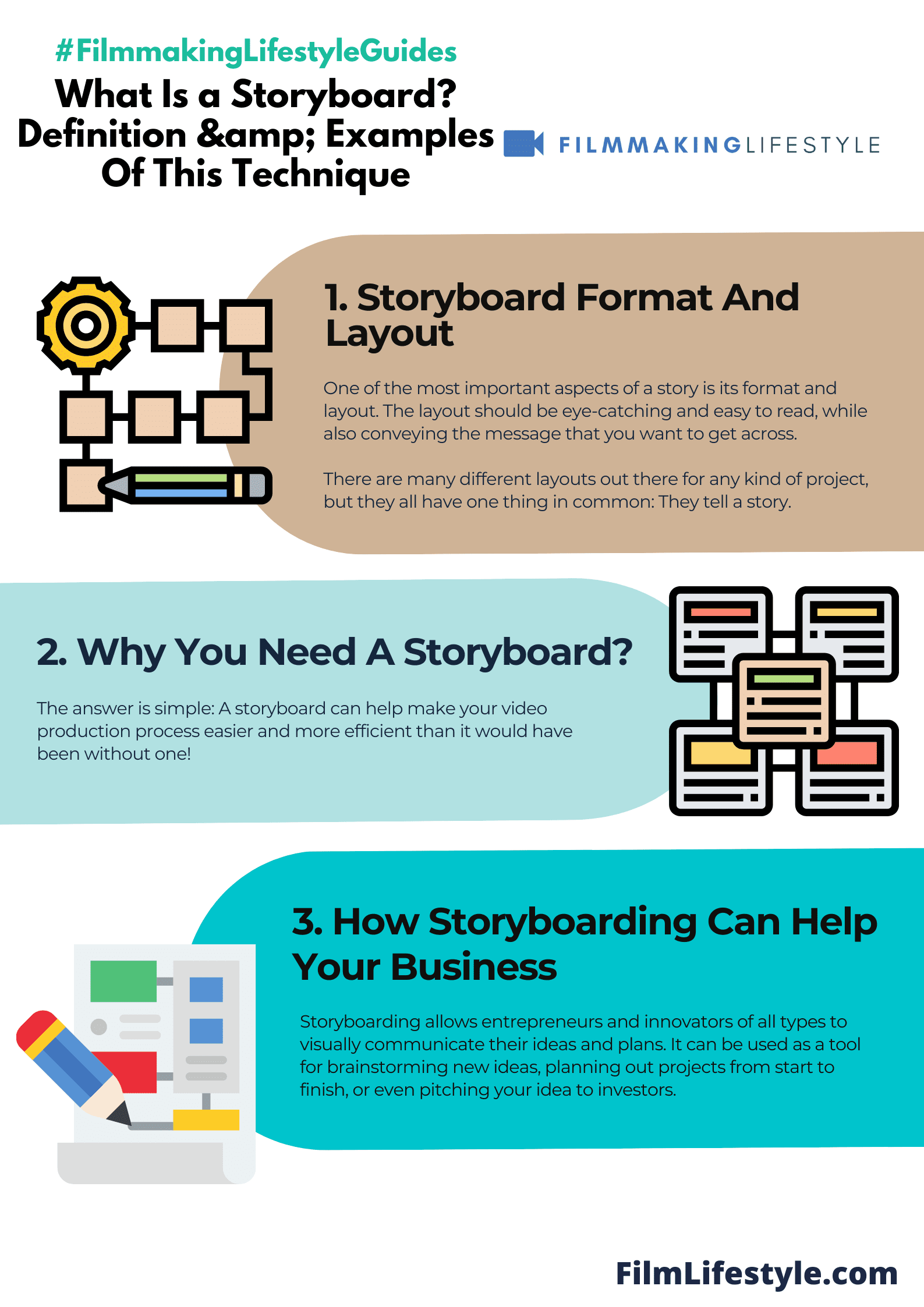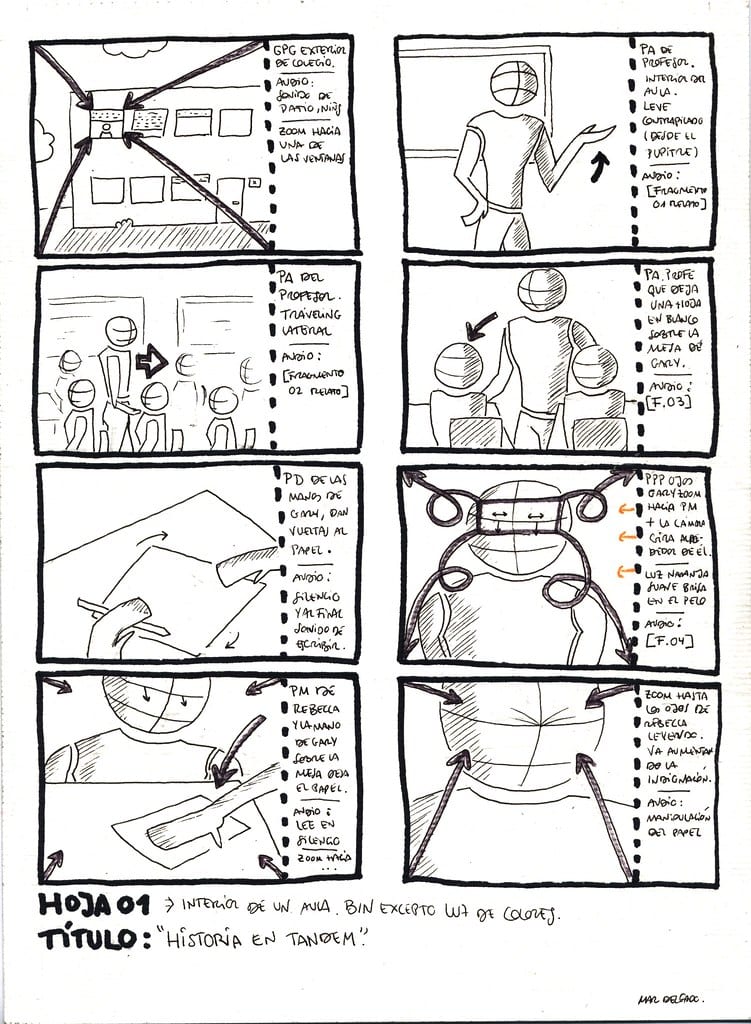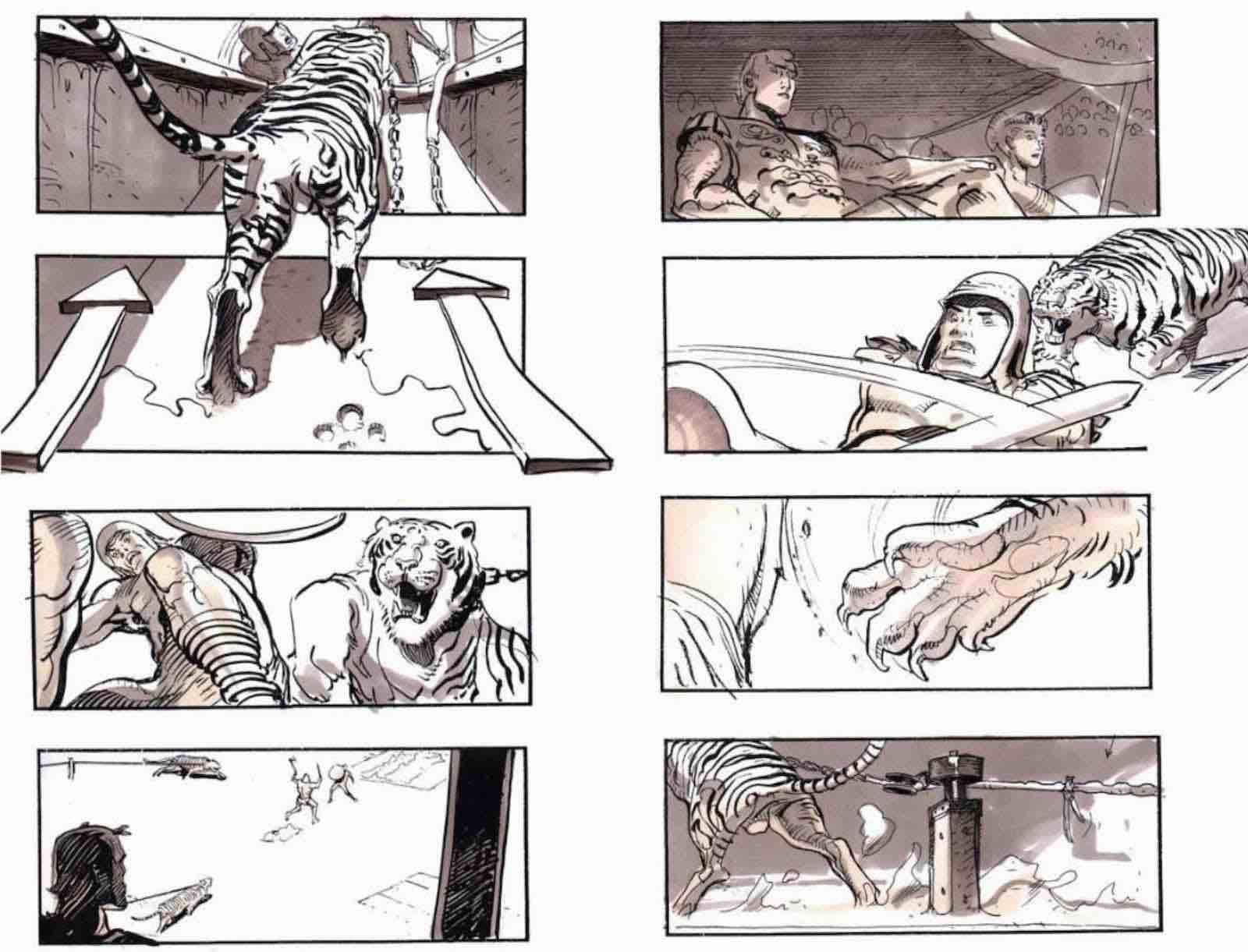- How To Storyboard
- How to Make a Storyboard
- Make A Storyboard Online
- Make A Music Video Storyboard
- Storyboard A Fight Scene
- Create a Documentary Storyboard
- Storyboard Photography
- Create An Animation Storyboard
- How To Display Storyboards
- Storyboard Camera Movement
- Storyboard Arrows
- Storyboard If You Can’t Draw
- Music Video Storyboard
- Create A Storyboard Demo Reel
- Storyboard Website Design
A storyboard is a visual representation of the shots that will be used in a film or video.
Storyboards are often hand-drawn and can serve as an important tool for communicating ideas to other people on the production team, such as directors, cinematographers, editors, and camera operators.
Are you a designer? A marketer? Is your team looking for a new way to present ideas, products, or services? A storyboard is an excellent tool that can help you get the job done. Let’s jump right in!
WHAT IS A STORYBOARD
What Is A Storyboard?
A storyboard is an artistically presented map of shots that allows you to create a visual representation of the flow of a film.
Beyond movies, you can use storyboards. This could be in the form of a timeline, storyboard, customer journey map, or even just some sketches on paper.
The key idea behind storyboarding is to come up with ideas and figure out what will work best the film.
Ever wondered how filmmakers and animators map out their visions before a single scene is shot?
That’s where a storyboard comes into play.
It’s a sequence of drawings that outline the tale frame by frame, providing a visual guideline for production teams.
In our deep dive, we’ll explore what a storyboard is, its crucial role in the creative process, and why it’s indispensable for visual storytelling.
From blockbusters to indie films, storyboards are the unsung heroes behind the scenes.
Stick with us as we unveil the magic of storyboards, and you’ll see just how they bring stories to life long before the cameras start rolling.
Whether you’re a budding filmmaker or a curious cinephile, there’s something fascinating to learn about this pivotal step in the journey from script to screen.
What Is A Storyboard
Storyboards are the blueprint in filmmaking that bridge the gap between written scripts and the final movie.
They assist in visualizing scenes and sequences by breaking down the action into individual panels, much like a comic strip.
Each panel represents a shot and conveys essential information.
It describes camera angles, character positions, and transitions between shots that give a glimpse of how the film will eventually play out on screen.
They are vital in pre-production because they provide a shared language for the entire crew.
Directors use storyboards to communicate their vision, including complex sequences that rely heavily on visual effects.
The process of creating a storyboard encompasses several key elements – – Sketching out each frame to represent a shot or a scene
- Adding dialogue or action notes to guide the team,
- Determining camera movements such as pans, tilts, or zooms.
Aside from laying out the visual narrative, storyboards help in identifying potential issues before filming begins.
They can reveal if certain scenes are impractical or too costly to shoot and allow filmmakers to make adjustments in the planning stage.
They’re not just for big-budget movies.
Storyboards are equally important in animation, advertising, and video games.
They help crystalize ideas and ensure that the complex interplay of visuals and storytelling is coherent and compelling.
Historically, storyboard artists were key collaborators in the creation of classic films.
For example, Alfred Hitchcock and Walt Disney relied heavily on storyboards for films like Psycho and Snow White and the Seven Dwarfs.
Their legacies underline the storyboard’s crucial role in the filmmaking process.
Storyboards pave the way for a smoother production.
They’re the map we follow, ensuring we’re all headed in the same direction toward the ultimate goal of bringing a story to life on screen.
The Role Of A Storyboard In The Creative Process
When diving into the realm of film production, understanding the role of a storyboard in the creative process is crucial.
Storyboards are more than just illustrations; they’re a tool for pre-visualization that gives us the ability to outline our vision frame by frame.
Each storyboard panel represents a key moment in the spectacle, capturing everything from camera angles to lighting.
It’s here where creative decisions are made, where scenes take shape before they’re brought to life.
We rely on storyboards to plan the narrative flow of a film.
They allow us to experiment with the pacing of the story, arranging and rearranging scenes for maximum impact.
Storyboards clarify complex sequences, particularly those laden with special effects or stunts.
They mark the transformation of the written word into visual storytelling.
Collaboration is the heartbeat of filmmaking, and storyboards strengthen communication among all parties involved.
From the director to the cinematographer, from the production designer to the VFX team, everyone gains a clear understanding of the project’s visual objectives.
Imagine trying to describe a chase scene in Mad Max: Fury Road without a visual aid.
Storyboards turn abstract ideas into a tangible reference that we can dissect, discuss, and develop.
As we iterate and refine our storyboards, our film starts taking shape well before we step onto set.
We’re armed with a plan – a course of action that significantly reduces guesswork and costly improvisation during production.
Here’s how storyboards Help our creative process:
- Provide a clear visual language for complex scenes,
- Guide the narrative flow and pacing,
- Foster collaborative input and decision-making,
- Aid in budgeting and scheduling by pinpointing resource needs,
- Allow for early identification and troubleshooting of potential problems.
In the hands of a skilled storyboard artist, the static images become a dynamic stepping stone to the finished film.
They’re the visual poetry that translates a script’s potential into cinematic reality, long before the cameras start rolling.
The Importance Of Storyboards In Visual Storytelling
In the realm of visual storytelling, storyboards are indispensable.
They transform abstract ideas into tangible visual sequences, providing a concrete reference point for directors, cinematographers, and the entire crew.
Storyboards act as the visual scaffolding from which the final product is built, ensuring that the vision of the storyboard artist aligns with that of the director and the scriptwriter.
Storyboards aren’t just sketches – they’re a strategic tool in filmmaking.
By laying out the sequence of shots before filming begins, we can pre-emptively tackle logistical challenges and make more informed decisions about camera angles, lighting, and the movement of actors within the frame.
These storyboards effectively become a roadmap for both the production’s aesthetic and practical execution.
We leverage storyboards to enhance communication among the production team.
The visualization of sequences builds a common understanding and harmonizes efforts across departments, from visual effects to wardrobe.
Storyboards serve not just as a guide but as a conversation starter, sparking collaboration that can lead to creative innovation and enhanced storytelling.
And it’s not just about the big picture – storyboards help us fine-tune the details:
- Choreographing action scenes for clarity and impact,
- Aligning musical scores with the on-screen action,
- Timing comedic beats to maximize audience response,
- Sequencing dialogue and performances for emotional resonance.
When we consider the complex world of visual effects, storyboards are especially critical.
They allow us to pre-visualize the integration of CGI elements into live-action footage, ensuring that the effects serve the story rather than detract from it.

By pre-planning these elements, storyboards help maintain narrative coherence within visually stunning spectacles like Inception or the Marvel Cinematic Universe.
How Storyboards Are Used In Film And Animation Production
When delving into the intricate process of film and animation production, storyboards hold a pivotal role.
They serve as the visual script that guides the entire crew, from camera operators to actors, on the journey from concept to screen.
In film production, every detail matters and storyboards ensure that nothing is left to chance.
They lay out camera angles, actor movements, and the sequence of shots that drive the narrative forward.
Animation production relies even more heavily on storyboards.
Here, storyboards are the crucial roadmap that animators follow, dictating the flow of the animation and synchronizing voice-overs with movements.
Beyond the basic layout of scenes –
- Storyboards Help the seamless planning of transitions and special effects,
- They enable adjustments in pacing and timing to be made before costly animation begins.
Consider The Lion King or Toy Story, where storyboards played an essential role in bringing these classics to life.
Complex sequences were first drawn, debated, and choreographed in storyboard form before becoming the iconic scenes we all love.
With the integration of digital technology, storyboards now often evolve into animatics.
These rough animations are invaluable for fine-tuning the final product without incurring the high costs of full-scale production changes.
Filmmakers and game designers alike turn to storyboards as an indispensable tool.
They not only convey the essence of the story but also encompass the technical aspects of production that are vital for coordinating large teams and complex sequences.
In our realm of filmmaking and digital storytelling, we cannot overstate the importance of storyboards.
They empower us to visualize and execute our visions with a clarity that ensures every member of the production team is aligned with the final goal.
What Is A Storyboard – Wrap Up
We’ve seen that storyboards are the backbone of visual storytelling, providing a clear roadmap for productions to follow.
They’re not just a tool for filmmakers and animators but a canvas where the essence of the story comes to life before any actual filming or animating begins.
By embracing the power of storyboards, we ensure that our vision is communicated effectively, saving both time and resources.
As technology advances, so does the sophistication of storyboarding, making it an even more vital part of the creative process.
Let’s continue to harness this powerful tool to craft compelling narratives that resonate with audiences around the world.
Frequently Asked Questions
What Is The Purpose Of A Storyboard In Filmmaking?
A storyboard in filmmaking acts as a visual script, guiding crew members through the visual narrative, from camera angles and actor movements to the sequence of shots, ensuring that the concept is successfully brought to screen.
How Important Are Storyboards In Animation Production?
In animation production, storyboards are essential as they map out the flow of animation, synchronize voice-overs and movements, and plan transitions, special effects, and pacing, crucial for production efficiency and cost management.
What Role Do Storyboards Play In Planning A Film?
Storyboards play a critical role in planning a film by setting up camera angles, actor positioning, and the sequence of events, thereby providing a clear blueprint for the entire production team to follow.
How Have Digital Technologies Influenced Storyboarding?
Digital technologies have modernized storyboarding by introducing animatics, which allow for detailed previsualization and fine-tuning of scenes, helping to save time and reduce production costs.
Why Are Storyboards Indispensable For Game Designers?
For game designers, storyboards are indispensable as they convey the essence of the story and coordinate complex sequences and large teams, fostering clear communication and a unified vision throughout the design process.
Matt Crawford
Related posts
6 Comments
Leave a Reply Cancel reply
This site uses Akismet to reduce spam. Learn how your comment data is processed.










Thanks for sharing this informative post on storyboards! It’s given me a better understanding of the technique and its applications. I’m definitely going to try using it for my next video project. Great post!
Really appreciate your comment! Thanks for sharing your thoughts.
I never knew the importance of storyboards until I read this blog post. It’s amazing how it helps artists and filmmakers visualize their ideas before bringing them to life! I’m definitely going to apply this technique to my own creative projects. Thanks for sharing the examples, it really helped me understand this concept better!
Thanks! Always great to have discussions like this.
Really enjoyed this post! I’ve been looking to improve my visual storytelling skills and this explanation of a storyboard has been super helpful. The examples were great too, thanks for breaking it down so clearly!
Thanks! I appreciate you taking the time to engage.